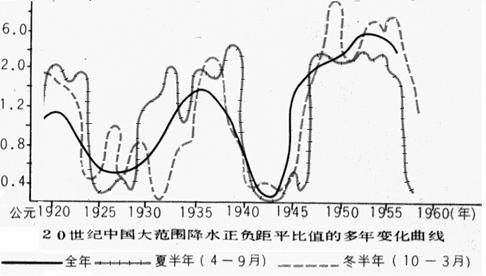分析“20世纪中国大范围降水正负比值的多年变化曲线图”及下列材料,完成题目要求: (10分)
气候学和长期预报中常用气候要素的距平值,表示当年值偏离常年值或单点要素值偏离区域平均值的情况。降水距平比值=当前值-多年均值

(1)我国20世纪二十年代至六十年代降水最少的年份是 ,
最多的年份是 。(2分)
(2)结合下表,可以看出我国气候冷暖与干湿呈现出 变化规律,根据此规律填出表格中1961——1970年的气候状况。(2分)
中国冷暖与干湿气候的变化(1921—1970年)
| 年代 | 1921—1930 | 1931—1940 | 1941—1950 | 1951—1960 | 1961—1970 |
| 干湿状况 | 干 | 湿 | 干 | 湿 | |
| 冷暖状况 | 暖 | 冷 | 暖 | 冷 |
(1)四十年代前半叶或1943年前后任一年即可(1分); 五十年代前半叶或1955年前后任一年即可(1分)
(2)交替(1分)
| 年代 | 1921—1930 | 1931—1940 | 1941—1950 | 1951—1960 | 1961—1970 |
| 干湿状况 | 干 | 湿 | 干 | 湿 | 干 |
| 冷暖状况 | 暖 | 冷 | 暖 | 冷 | 暖 |
(3)海平面上升,会淹没我国沿海低地;我国粮食生产会受到影响,不同区域粮食产量可能发生变化;我国干旱或洪涝灾害的频次和强度增加;冰川雪线会上升(以上任答三点即可,每点二分)。
题目分析:(1)直接读图,“降水最少的年份”应看全年降水量距平值最低的点,大约在1943年前后。而“降水量最多的年份”应看全年降水量距平值最高的点,大约在1955年前后。(2)结合图示和表格资料反映,我国气候冷暖与干湿状况呈交替变化。根据上一个年份的干湿状况和冷暖状况判断1961—1970年的干湿与冷暖状况,与前一阶段相反。(3)借鉴课本关于全球变暖对自然环境的影响,主要从影响降水量、冰川雪盖面积缩小、海平面上升,淹没沿海低地国家或地区等方面分析。
点评:本题难度一般,学生只要抓住“距平值”的含义,直接从图示和资料中提取有效信息,并调用课本关于全球气候变暖的影响等内容分析即可。
